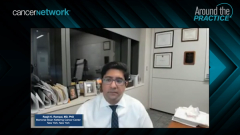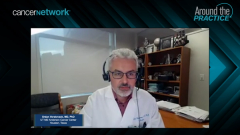
Approaching a Case of Primary Myelofibrosis
Review of criteria used to assess and plan treatment for a 67-year-old patient with primary myelofibrosis.
Episodes in this series

John Mascarenhas, MD: Let’s move on to the first patient case. This is a 67-year-old woman who presents to her primary care physician with fatigue, increased bruising, and left upper-quadrant abdominal pressure for about a 2-month period. Her past medical history is noted for well-controlled hypertension. On an abdominal exam, she has a palpable spleen about 4 centimeters below the left costal margin, and on labs; hemoglobin of 9.8, platelets of 215,000, and a white [blood cell] count of 17,000. A bone marrow biopsy is done. It shows a hypercellular bone marrow with an increase in atypical megakaryocytes, MF-3 grade fibrosis, and CD34/CD117 staining is only 1.3% for blasts. JAK2 V617F qualitative, or quantitative testing rather, shows a 30% mutation level and the diagnosis is made of primary myelofibrosis.
Now, the audience polling question is, what is the risk status of this patient described? Is it: (A) low, (B) Intermediate, (C) high, or (D) unable to calculate based on the data at hand. I'll ask you to please vote.
While they're voting, Aaron, I'll start with you. If you size up a patient like we just described, 67, has symptoms, has a big spleen, has anemia, platelets are not that low thankfully, doesn't have an increase in blasts, and has about a 30% JAK2 mutation. Where does a patient like that fall in terms of risk score?
Aaron T. Gerds, MD: You can certainly apply a couple of different risk scores, some of the older risk scores like [an older scoring system]. Or even with recent bone marrow, in cytogenetics, you could do a DIPSS or a DIPSS-plus score to estimate a patient's risk. This patient certainly doesn't have, or doesn't seem to have, rip-roaring disease. It's not accelerating towards blast phase disease or acute leukemia, which I think is a really important point. I think Srdan so eloquently put it, when we think about disease risk and whether we want to refer this patient to transplant. I think when I was would assess this patient, I would also consider getting a mutation analysis to see if would tip my hand one way or the other in terms of disease risk and potential transplantation because this patient's in their back half of their 60s, you might want to think about transplant a little sooner rather than later. But ultimately, it comes down to really how they're feeling. It sounds like this person has splenomegaly and some symptoms and I would probably try to unpack that a little bit more with the MPN 10, and a good physical exam, and maybe even ultrasound if I need to, to see if we should be starting some sort of therapy?
John Mascarenhas, MD: I think that leads right into our audience polling question number 3. How would you treat this patient who appears to have a sort of an intermediate risk disease status? Is it (A) phlebotomy, (B) hydroxyurea, (C) interferon alpha, (D) transplant, (E) ruxolitinib or (F) would you actually watch and wait a patient, as Aaron said, that is symptomatic with a big spleen? I'll ask you to please vote now.
Srdan, if you saw this person, older, clearly has symptom burden, has a big spleen, and has some degree of anemia, what would be your first line therapy for this patient?
Srdan Verstovsek, MD, PhD: I would not watch and I would not wait. At age 67, it's still good for the transplant. Certainly, I agree with Aaron on further assessment of the NGS [next-generation sequencing] panel will perhaps push me even faster to recommend the transplant. And we want to eventually cure the patient, so that would be the goal. Now in between today, when I see the patient, and the transplant, I will still treat the patient for the symptoms and the spleen. And if the anemia worsens, through therapy with JAK inhibitors, which will be my choice, maybe add an anemia drug on top of it to help the patient get to their transplant in the best possible shape.
John Mascarenhas, MD: I think the audience agrees, almost 80% of the participants picked ruxolitinib. I think the point you made is very important though. I don't think it is ruxolitinib and then the end. It's ruxolitinib often with this goal, and of course, it may not be for every 67-year-old. There may be some 67-year-olds that have a life view that is not consistent with a transplant, and that's okay, but I think it does a disservice to the patient not to at least have that conversation. And in my opinion, have them see the transplanters because there's nothing more frightening to a patient than to hear a transplanter talk about the risks involved with a transplant. It’s an important discussion and it may end up not being for that individual person and that's fine but what you don't want to do is try to figure out that's what they would have wanted at the back end when they're not doing well on ruxolitinib. I think that that's totally in line with the rest of the panelists. Raajit, would you agree?
Raajit K. Rampal, MD, PhD: Totally agree. One of the things I always say to patients is, "The time to see the transplanter is not when you need a transplant." I think that is the principle that we're all echoing here. I think that's absolutely essential. For a variety of reasons, as you said, the time for them to meet the transplant and to hear the conversation, which is not a reassuring conversation, is not when they're sick. And of course, is the practical matter of trying to figure out, does this person have a donor? Do we have a good donor? Is this person physically fit? And ultimately, is this a decision that fits in with their life goals? Because, of course, it's not for everyone.
Transcript edited for clarity.
Newsletter
Stay up to date on recent advances in the multidisciplinary approach to cancer.


















































































